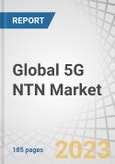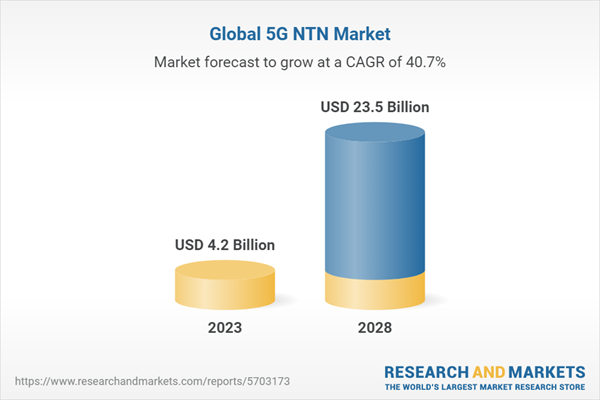Asia-Pacific to Register the Highest CAGR During the Forecast Period
The global 5G NTN market is estimated at USD 4.2 billion to USD 23.5 billion at a CAGR of 40.7% from 2023 to 2028. The drive to enhance 5G network coverage in remote and underserved regions will generate increased demand for High Altitude Platform Stations (HAPS), Geostationary Earth Orbit (GEO), and various other platforms within the 5G NTN landscape. This surge in demand aligns with several other catalysts, including the growing adoption of smart devices, escalating requirements for seamless connectivity in diverse environments, and the imperative to bridge digital divides in marginalized areas. Additionally, the push for reliable connectivity in critical sectors such as healthcare, agriculture, and education further fuels the momentum toward diversified 5G NTN platforms.
By platform, LEO satellite to register higher CAGR during the forecast period
LEO is gaining prominence as the preferred solution for developing 5G NTN systems, promising enhanced network coverage and abundant opportunities to bridge connectivity gaps. Governments worldwide are actively supporting the expansion of network coverage by integrating terrestrial networks with LEO satellites to establish robust 5G NTN systems. This commitment exemplifies the USD 600 million deal signed in July 2019 between the Government of Canada and Telesat, aiming to alleviate the connectivity gap across the country through Telesat's LEO satellite constellation.
In a notable collaboration, MediaTek and Rohde & Schwarz joined forces in August 2022 to showcase the capabilities of 5G NTN. This demonstration involved conducting a NodeB network (gNB) test over an LEO satellite, marking a significant milestone in achieving more reliable and faster connectivity. MediaTek further achieved a groundbreaking feat by powering a smartphone with a 5G NTN connection for the first time, showcasing the tangible progress and innovation within the realm of non-terrestrial 5G networks.
By application, eMBB to account for the largest market share during the forecast period
The emphasis of 5G NTN is on deploying eMBB to deliver high bandwidth with moderate latency, support high mobility up to approximately 500 kilometers per hour, and efficiently handle a staggering 10,000 times more traffic. Release - 18 introduces several use cases related to eMBB, including mobility enhancement, Multiple Input Multiple Output (MIMO) technology, and network power-saving measures. Major industry players are increasingly adopting eMBB to provide 5G network connectivity comparable to LTE services. In the context of 5G NTN, eMBB services play a crucial role in extending excellent broadband connectivity to rural and underserved areas, particularly on dynamic platforms such as aircraft and vessels. This strategic deployment enhances connectivity options and addresses the diverse needs of users across a spectrum of scenarios and locations.
Asia Pacific to register the highest growth rate during the forecast period
The Asia Pacific region is set to undergo significant growth opportunities in the coming years, with countries like India, China, Australia, and New Zealand expected to experience high growth rates. The competition in the region is fragmented, prompting 5G NTN solution providers to expand their operations across various countries. The imperative to enhance public safety during disasters and emergencies further fuels the adoption of 5G NTN solutions in the region. Various industries, including aerospace, maritime, and defense, are embracing integrated 5G networks and satellite-based solutions to augment network coverage across diverse and challenging locations. In the maritime sector, the adoption of maritime satellite technology stands out, facilitating advanced communication networks that enable seamless connectivity with employees stationed at remote offshore locations. This multifaceted adoption of 5G NTN technologies reflects the region's commitment to leveraging innovative solutions for improved public safety, infrastructure development, and connectivity across key industries.
Breakdown of Primaries
The study contains insights from various industry experts, from solution vendors to Tier 1 companies. The break-up of the primaries is as follows:
- By Company Type: Tier 1 - 25%, Tier 2 - 40%, and Tier 3 - 35%
- By Designation: C-level - 45%, D-level - 35%, and Others - 20%
- By Region: North America - 40%, Europe - 35%, Asia Pacific - 20%, and RoW - 5%
The major players in the 5G NTN market are Qualcomm Technologies, Inc. (US), SoftBank Group Corporation (Japan), Thales Group (France), Rohde & Schwarz GmbH & Co KG (Germany), Keysight Technologies, Inc (US), MediaTek Inc. (Taiwan), SES S.A. (Luxembourg), EchoStar Corporation (EchoStar) (US), SpaceX (US), AST & Science, LLC (US), ZTE Corporation (China), OneWeb (UK), GateHouse SatCom A/S (Denmark), Omnispace, LLC (US), Nelco Limited (US), Inmarsat Global Limited (UK), Skylo Technologies (US), Globalstar, Inc (US), Spirent Communications (Spirent) (UK), Telefonaktiebolaget LM Ericsson (Sweden), Nokia Corporation (Finland), Intelsat US LLC (US), and Telefonica S.A. (Spain), Viasat Inc, (US), Telesat (Canada), Satelitiot (Barcelona), Kuiper Systems LLC (US ), and SpaceIoT (China). These players have adopted various growth strategies, such as partnerships, agreements and collaborations, new product launches, product enhancements, and acquisitions to expand their footprint in the 5G NTN market.
Research Coverage
The market study covers the 5G NTN market size across different segments. It aims to estimate the market size and the growth potential across different segments, including components (hardware, software, and services), platforms, applications, end-use industries, locations, and regions. The study includes an in-depth competitive analysis of the leading market players, their company profiles, key observations related to product and business offerings, recent developments, and market strategies.
Key Benefits of Buying the Report
The report will help the market leaders/new entrants with information on the closest approximations of the global 5G NTN market's revenue numbers and subsegments. This report will help stakeholders understand the competitive landscape and gain more insights to position their businesses better and plan suitable go-to-market strategies. Moreover, the report will provide insights for stakeholders to understand the market's pulse and provide them with information on key market drivers, restraints, challenges, and opportunities.
The report provides insights on the following pointers:
- Analysis of key drivers (adoption of software-centric approach, need to address extreme coverage extension, 3GPP evolution toward NTN interworking and integration), restraints (need for radio components to be on the ground), opportunities (impact of NR-NTN integration on 5G connectivity, need for NTN in evolution toward 5G and 6G, 5G NB-IoT NTN to contribute to global high speed) and challenges (signal interception, propagation delay and low latency due to large distance between satellites and terrestrial user equipment, doppler frequency shift owing to mobility issues) influencing the growth of the 5G NTN market.
- Product Development/Innovation: Detailed insights on upcoming technologies, research & development activities, and new product & service launches in the 5G NTN market.
- Market Development: Comprehensive information about lucrative markets - the report analyses the 5G NTN market across various regions.
- Market Diversification: Exhaustive information about new products & services, untapped geographies, recent developments, and investments in the 5G NTN market.
- Competitive Assessment: In-depth assessment of market shares, growth strategies, and service offerings of leading players like Qualcomm Technologies, Inc (US), SoftBank Group Corporation (Japan), Thales Group (France), Rohde & Schwarz GmbH & Co KG (Germany), Keysight Technologies, Inc (US), MediaTek Inc. (Taiwan), SES S.A. (Luxembourg), EchoStar Corporation (EchoStar) (US), SpaceX (US), AST & Science, LLC (US), ZTE Corporation (China), OneWeb (UK), GateHouse SatCom A/S (Denmark), Omnispace, LLC (US), Nelco Limited (US), Inmarsat Global Limited (UK), Skylo Technologies (US), Globalstar, Inc (US), Spirent Communications (Spirent) (UK), Telefonaktiebolaget LM Ericsson (Sweden), Nokia Corporation (Finland), Intelsat US LLC (US), and Telefonica S.A. (Spain), Viasat Inc, (US), Telesat (Canada), Satelitiot (Barcelona), Kuiper Systems LLC (US ), and SpaceIoT (China).
Table of Contents
The global 5G NTN market is estimated at USD 4.2 billion to USD 23.5 billion at a CAGR of 40.7% from 2023 to 2028. The drive to enhance 5G network coverage in remote and underserved regions will generate increased demand for High Altitude Platform Stations (HAPS), Geostationary Earth Orbit (GEO), and various other platforms within the 5G NTN landscape. This surge in demand aligns with several other catalysts, including the growing adoption of smart devices, escalating requirements for seamless connectivity in diverse environments, and the imperative to bridge digital divides in marginalized areas. Additionally, the push for reliable connectivity in critical sectors such as healthcare, agriculture, and education further fuels the momentum toward diversified 5G NTN platforms.
By platform, LEO satellite to register higher CAGR during the forecast period
By application, eMBB to account for the largest market share during the forecast period
Asia Pacific to register the highest growth rate during the forecast period
Breakdown of primaries
Research Coverage
Key Benefits of Buying the Report
The report provides insights on the following pointers:
Companies Mentioned
- Ast Spacemobile
- Echostar Corporation
- Ericsson
- Gatehouse
- Globalstar
- Inmarsat Global
- Intelsat
- Keysight Technologies
- Kuiper Systems
- Mediatek
- Nelco
- Nokia
- Omnispace
- Oneweb
- Qualcomm Technologies
- Radisys
- Rohde & Schwarz
- Sateliot
- Ses
- Skylo
- Softbank Group
- Spaceiot
- Spacex
- Spirent Communications
- Telefonica
- Telesat
- Thales
- Viasat
- Zte
Table Information
| Report Attribute | Details |
|---|---|
| No. of Pages | 185 |
| Published | December 2023 |
| Forecast Period | 2023 - 2028 |
| Estimated Market Value ( USD | $ 4.2 Billion |
| Forecasted Market Value ( USD | $ 23.5 Billion |
| Compound Annual Growth Rate | 40.7% |
| Regions Covered | Global |
| No. of Companies Mentioned | 29 |









